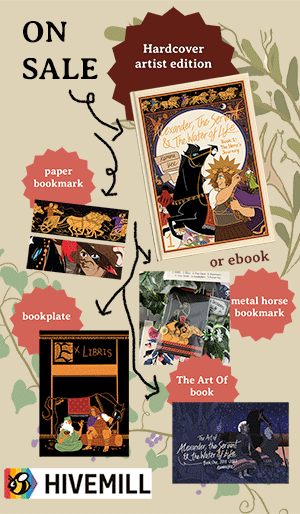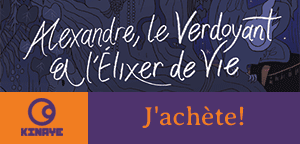
British Library 2022 Interview
This is a copy of an interview done in conjuction with the Alexander the Great: The Making of Myth exhibition at the British Library. The original page was here (site is currently down due to data breach).
An interview with Reimena Yee: creator of a modern Alexander Romance | The British Library
Reimena Yee is the creator a modern retelling of the Alexander Romance. Alexander, The Servant and the Water of Life is an on-going graphic novel published online.
What first drew you to Alexander the Great and made you want to tell his story?
My first proper encounter with Alexander was through Kanishk Tharoor’s short story collection Swimmer Among the Stars. Included in the collection was a series of retellings about the Persian / Mughal face of Alexander, Iskander, and how he built the first lighthouse, defeated the fairies, explored the sea in a submarine, and other strange anecdotes.
At the time, I had no real knowledge of Alexander the Great. I thought he was an ancient Greek conqueror, one of those ‘Great Men’ in history that I couldn’t be bothered with. So, I was surprised to see that 1) Alexander could be a character of such imaginative adventures, and; 2) this isn’t just Tharoor’s authorial whimsy – he was actually engaging in a centuries old literary tradition, the Alexander Romance.
This was how Alexander introduced himself to me: as a legendary literary figure who travelled across cultures, faith traditions and time-periods. That impression stayed, biding its time, until it was distilled in the single image of Alexander riding on the back of Bucephalus with the Servant by his side. It was not until the end of 2018 – after several life-changing shifts and despite announcing my brief retirement from historical comics – that I decided that the calling I felt for the Alexander Romance was truly serious.
Do you consider Alexander, The Servant and the Water of Life to be a modern retelling of the Alexander Romance?
I had always intended to do a 21st century retelling of the Alexander Romance once I understood what it was: an inheritance passed down by artists across time. Every age has its own Alexander, and his legacy is repeatedly re-imagined to reflect the era's concerns of kingship and identity. Since it has been awhile since the last full retelling (taking into account how our world has changed between the 19th to 21st centuries), I wanted to take a crack at it.
My version is a historiographic metafiction that aims to marry both the visual and literary legacies and tropes of Alexander legends, and explore the many names and faces of Alexander, and the people who made him (the literary character and the actual person). So, it's always been big from the beginning, to my delight and chagrin.
Would you explain the title Alexander, The Servant and the Water of Life to us please?
The title describes the two main characters and the object of their quest; it references the first vision I ever had of them (the aforementioned image from the first question). The title references the set piece in which Alexander seeks out the Water of Life in the Land of Darkness. Alexander himself is never the one to find immortality. Instead, it would be his servant: the cook Andreas or the prophet al-Khidr. The title alludes to that tension, and the subversion inside the graphic novel later on.
Why did you decide to tell this tale as a graphic novel?
The sequential arts is the best medium for what I was aiming to do narratively, which is an examination of Alexander's many names and faces. Retelling the Alexander Romance as a graphic novel enables me to freely present and borrow references to Alexander in the visual arts (paintings, sculptures, jewels, mosaics, etc.) and literature. Most importantly, I'm able to introduce contradictions and comparisons on the same page non-linearly, which serves a thematic purpose. Additionally, the sequential arts is a new medium of storytelling that began in the late 19th century and matured in the 20th and 21st centuries, so it seemed appropriate for the retelling to be done as a graphic novel, the latest form of the book arts.
How did you go about your research?
The research is part of an ongoing, dynamic interaction in every stage of the comics-making process. The narrative and artistic choices are informed by research, and the research is inspired by those choices.
When I write the script, I research background details. Basically, the standard process of reading my sources and reading recent analyses of those sources. This is where my consultant, Richard Stoneman, comes in to double-check and suggest other things to look at, as he has read more about Alexander and the peripheral details. From there I try to make decisions that balance the needs of the story, historical plausibility, and the actual historical events. Fortunately, the Alexander Romance by its weird nature is quite flexible, but I still want to get the (recorded) historical events as accurate as possible.
However, it's when I am drawing, when I am actually embarking on the visual storytelling stage, that I research very closely on things. Material culture, art history, fashion, etc., all the visual details that carry the story in small and large ways. From big things like the size of a sarissa spear (about hand length) to little things like how the Greeks would drink from a kylix cup (fingers around the stem, however you like). I don't end my research process for each page until I lay down the colours.
Did you explore any material from the British Library?
My Alexander Romance cannot live without the British Library collections. In Chapter 7, to show Alexander's mediaeval faces, I took reference from manuscripts such as the Royal MS 20 B XX, Royal MS 15 E VI (The Talbot Shrewsbury) and Add MS 47680. And I have plans to continue use of the archives as the story progresses, especially for Alexander's Eastern faces.
Sometimes this using the British Library collections online can be an emotional moment. While I was doing the research for one particular spread I learned about a type of medieval manuscript that was called a model book – basically a version of an art reference book which provided stock motifs for artists and samples or flash sheets for commissioning clients. 600 years ago, artists would open one of these books and pick a letter, a border, a pattern, etc. to sample from for their project. In the year 2021, during a pandemic, I found myself doing the same from a digital scan of one of these books that's sitting in the British Library on the other side of the globe from me! How wild is that?! It's experiencing moments like these that makes me feel honoured and humbled to be a creator, to connect with my elders like this and be lucky to use the same tools they were using, unchanged, across 600 years.
Did you find it difficult to combine different versions of the tales from different cultures?
I don't have difficulty choosing which versions to combine so much as choosing where and how to combine them for the best impact. It's difficult to explain how I end up with whatever's on the page – generally I have a strong idea of what I want to say to my readers, then I go do my research or think a lot until something clicks.
Did you find yourself identifying more with tales from particular cultures, or time-periods?
My Alexander Romance leans towards the Eastern branch, perhaps unsurprising given my origin story. However, I'm borrowing tales from everywhere, while using Alexander's real life as the backbone.
How did you find the balance between the pre-existing stories, your own imagination and your research?
From the start, I knew how to tell my Alexander Romance: it's Alexander's biography, but problematised by his legends, then appropriated to say something about what power means now and how we depict this power in our stories. The pre-existing tales are used as allegories to reinforce a theme or moral; the researchis used to add a sense of humanity, thought and full-bodiness; and the imagination is to subvert and transform.
Were any pre-existing images or description of Alexander’s appearance that strongly influenced your depiction of him?
All of the images are equally fascinating to me. Other than the Lysippos bust (which is idealised), there is no image we have left that showed the face he had in real life.
Why did you decide to publish the comic online?
The internet is a 20th-21st century invention, so it's only right for the 21st century Alexander Romance to use it as a medium of transmission. Publishing it online and constructing a website around it allowed me to do things that wouldn't be possible in a print book due to its material limitations. On each comic page I am able to talk about my process; share my research; provide references and bibliography via hyperlinks to academic resources and digital archives; add transcripts; tell jokes… The website becomes its own multimedia experience shared between myself and my readers, where we're going on this creative journey in real time.
Do you have a favourite tale about Alexander and how did you depict this in your comic?
I only just finished Book 1 of my retelling (out of 4), so I haven't actually depicted very many of the legends yet. I really like one obscure Eastern tale in which Alexander steals a cup of sugar from a tree that's been converted into a grocer's market and he gets locked out of it.
The Trees of the Sun and Moon is one of my favourites because it represents a climatic shift in the Alexander Romances that feature it, including my own. I haven't yet reached the part in my story where Alexander meets the trees, but I have illustrated 8 pages of the scene exclusively for the exhibition at the British Library, based on an early draft.
How do you go about creating your comic?
A lot of my process especially in the early stages is thinking and experiencing, which can look a lot like ’doing nothing’ and looks unexciting or irrelevant to the actual physical or mental labour of writing or drawing. I have developed my own story outline and production method – called the Onion Method – which is basically two major elements (Character-Driven Plot, and Thematic Thesis) riffing off each other, creating alternating layers each in conversation with the previous and next layer. Others have described it as a socratic dialogue or you arguing to yourself to make the strongest narrative that you possibly can. Not the most logical or most plot-hole proof story! Just the one that is intellectually and creatively rigorous, and as honest and true to the spirit of what you are and what you want to say. This Onion Method sounds very intense, but to bring this back, it consists a lot of “doing nothing” while the onion develops.
When I actually engage in production, like in illustration, it's pretty ordinary. I go through the usual steps, from idea to thumbnails to sketches all the way to finals. With comics, I tend to prefer having a solid script first – by solid I mean, I've developed the onion so thoroughly that the core of the story will never change, since that process of elimination and thought and rigour has already been done. I do it like this because my visual style of comics layouts is so dependent on the turn of the page and how the left and right pages are composed in a spread. Any narrative changes could cascade and ruin the composition/flow of the visual storytelling. This doesn't mean I don't change a single thing or improve a layout, but there's more weight to that choice. That choice has to be beneficial or strong for the whole book.
What advice would you give to other storytellers and artists who are inspired by historical figures?
It's daunting and terrifying to be following the footsteps of larger than life figures, but there's so much joy and knowledge to be uncovered from the adventure. Fall down into as many rabbit holes as possible, and read widely and critically from a wide variety of sources. Most of all, have fun!
-
Alexander, the Servant and the Water of Life is on display in Alexander the Great: the Making of a Myth at the British Library, London until 19 February 2023. You can also read the graphic novel online.
Reimena Yee is a strange and fancy storyteller and illustrator originally from the city of Kuala Lumpur. She is the creator of the Eisner-nominated The Carpet Merchant of Konstantiniyya, the gothic suburban fantasy Seance Tea Party and the whimsical adventure comedy My Aunt is a Monster. She is also one of the core founders of UNNAMED, a Southeast Asian comics collective.



Newsletter
Follow the 21st century graphic novel retelling of the Alexander Romance, a
historical-fantastical
account about the life,
deeds and legends of Alexander the Great. Never miss a single update.
Privacy policy
